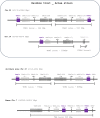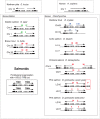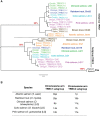Evolution of T cell receptor beta loci in salmonids
- PMID: 37649482
- PMCID: PMC10464911
- DOI: 10.3389/fimmu.2023.1238321
Evolution of T cell receptor beta loci in salmonids
Abstract
T-cell mediated immunity relies on a vast array of antigen specific T cell receptors (TR). Characterizing the structure of TR loci is essential to study the diversity and composition of T cell responses in vertebrate species. The lack of good-quality genome assemblies, and the difficulty to perform a reliably mapping of multiple highly similar TR sequences, have hindered the study of these loci in non-model organisms. High-quality genome assemblies are now available for the two main genera of Salmonids, Salmo and Oncorhynchus. We present here a full description and annotation of the TRB loci located on chromosomes 19 and 25 of rainbow trout (Oncorhynchus mykiss). To get insight about variations of the structure and composition of TRB locus across salmonids, we compared rainbow trout TRB loci with other salmonid species and confirmed that the basic structure of salmonid TRB locus is a double set of two TRBV-D-J-C loci in opposite orientation on two different chromosomes. Our data shed light on the evolution of TRB loci in Salmonids after their whole genome duplication (WGD). We established a coherent nomenclature of salmonid TRB loci based on comprehensive annotation. Our work provides a fundamental basis for monitoring salmonid T cell responses by TRB repertoire sequencing.
Keywords: T cell receptor; TRB locus; adaptive immunity; evolution; rainbow trout; repertoire; salmonid fish.
Copyright © 2023 Boudinot, Novas, Jouneau, Mondot, Lefranc, Grimholt and Magadán.
Conflict of interest statement
The authors declare that the research was conducted in the absence of any commercial or financial relationships that could be construed as a potential conflict of interest.
Figures








Similar articles
-
Profiling the T Cell Receptor Alpha/Delta Locus in Salmonids.Front Immunol. 2021 Oct 18;12:753960. doi: 10.3389/fimmu.2021.753960. eCollection 2021. Front Immunol. 2021. PMID: 34733285 Free PMC article.
-
Standardized IMGT® Nomenclature of Salmonidae IGH Genes, the Paradigm of Atlantic Salmon and Rainbow Trout: From Genomics to Repertoires.Front Immunol. 2019 Nov 12;10:2541. doi: 10.3389/fimmu.2019.02541. eCollection 2019. Front Immunol. 2019. PMID: 31798572 Free PMC article.
-
Genomic arrangement of salinity tolerance QTLs in salmonids: a comparative analysis of Atlantic salmon (Salmo salar) with Arctic charr (Salvelinus alpinus) and rainbow trout (Oncorhynchus mykiss).BMC Genomics. 2012 Aug 24;13:420. doi: 10.1186/1471-2164-13-420. BMC Genomics. 2012. PMID: 22916800 Free PMC article.
-
Characterization of the ferret TRB locus guided by V, D, J, and C gene expression analysis.Immunogenetics. 2020 Feb;72(1-2):101-108. doi: 10.1007/s00251-019-01142-9. Epub 2019 Dec 3. Immunogenetics. 2020. PMID: 31797007 Free PMC article. Review.
-
Characterization of free fatty acid receptor family in rainbow trout (Oncorhynchus mykiss): towards a better understanding of their involvement in fatty acid signalisation.BMC Genomics. 2023 Mar 20;24(1):130. doi: 10.1186/s12864-023-09181-z. BMC Genomics. 2023. PMID: 36941594 Free PMC article. Review.
Cited by
-
Squamate reptiles may have compensated for the lack of γδTCR with a duplication of the TRB locus.Front Immunol. 2025 Jan 9;15:1524471. doi: 10.3389/fimmu.2024.1524471. eCollection 2024. Front Immunol. 2025. PMID: 39850903 Free PMC article.
References
-
- Flajnik M, Du Pasquier L. Evolution of the immune system. In: Paul W, editor. Fundam. Immunol., 7th edn. (2012) New York: Wolters Kluwer & Lippincott Willians & Wilkins. p. 67–128.
-
- Lefranc M-P, Lefranc G. The immunoglobulin FactsBook. London (UK): Academic Press; (2001).
Publication types
MeSH terms
LinkOut - more resources
Full Text Sources

